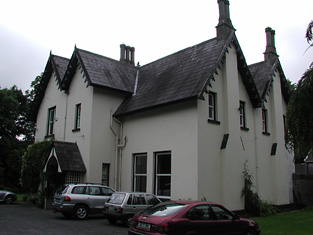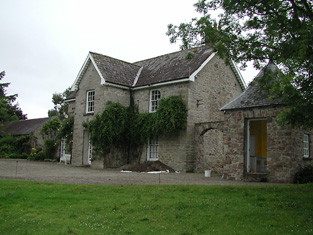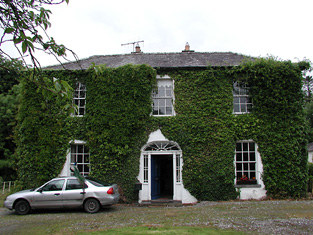New Ross
Houses within 5km of this house
Displaying 14 houses.
Houses within 5km of New Ross
Displaying 14 houses.
| House name | Description | |
|---|---|---|
| Cragg | The home of a branch of the Going family, occupied by Robert Going in 1814 and in 1837. Robert died in 1838 and was succeeded by his son John. In 1840 the Ordnance Survey Name Books describe Cragg as "formerly the residence of John Going, it is now going to wreck". He still held Cragg at the time of Griffith's Valuation when the house was valued at £12+. John Going of Cregg House, Birdhill, owned 1,896 acres in the 1870s. A new house was built to the south west of the original house circa 1880 [R709 652]. John's son, Robert Edward Going, had succeeded to Traverston by the early 20th century. The second Cragg House is still extant. |

|
| Barna | Barna was the home of the Lee family in the 18th and first half of the 19th century. Leet records G. Lee as resident in 1814 and H. Lee was the proprietor in 1837 and at the time of Griffith's Valuation when the house was valued at £23+. This house no longer exists. | |
| Mountphilips | In 1786 Wilson refers to Mount-Phillips as the seat of Counsellor Phillips. Mount-philips was the home of William Philips in the first half of the 19th century. In the early 1850s the house was valued at £21+ and held in fee. By 1906 it was valued at £17 and occupied by John P. Phillips. This house no longer exists. Wilson also makes reference to another Phillips residence, at Killeen, nearby. | |
| Mount Rivers | The seat of the Phillips family, occupied by Richard Philips in the first half of the 19th century and held by him in fee. The house was valued at £30 at the time of Griffith's Valuation. The sale rental of 1874 describes Mount Rivers as "a fine modern country mansion in thorough repair" and gives a description of the rooms and out houses. Wyndham Gabbett occupied the mansion house valued at £27 in 1906. In 2013 the property was offered for sale. |

|
| Castle Waller | The seat of the Waller family in the 18th and first half of the 19th century, occupied by Richard Waller in 1814 and in 1837. In 1840 the Ordnance Survey Name Books reported that is was then uninhabited. Thomas Mullowney [possibly the youngest son of Croasddaile Molony] was the occupant at the time of Griffith's Valuation when the buildings were valued at £17. Castle Waller was occupied for sometime in the 1850s by William de Rythre who married Blanche Waller. In the 1870s Michael Moloney of Castle Waller owned 5 acres. The building was in ruins by the early 20th century. | |
| Rockvale | Reverend M. Moore was the proprietor of Rockvale in 1837. In 1840 the Ordnance Survey Name Books note it as the seat of Rev. A. Armstrong and describe it as " a commodious dwelling house". Francis J. O'Neill was the occupier in the early 1850s. He held the house, offices and flour mills, valued at £61 from John F. Waller. A house is still located at this site. | |
| Oakhampton | In 1786 Wilson mentions Oakhampton as the seat of Joseph "Phelps". John Philips was resident here in 1814 and S.W. Phillips in 1837. Lewis writes that it was the property of Lord Bloomfield. In 1840 the Ordnance Survey Name Books record Oakhampton as " a good dwelling house, the residence of Mr. S. Phillips". The Reverend Anthony Armstrong was the occupant at the time of Griffith's Valuation, holding the property from Lord Bloomfield. The buildings were valued at £25+. Reverend Anthony was still resident in the 1870s when he owned 504 acres in county Tipperary. Reverend A. Armstrong was rector of Killoscully and, in 1835, married Anna Going of Ballyphilip. Oakhampton is still extant. |

|
| Ballymackeogh | The seat of the Ryan family for much of the 18th and 19th centuries, occupied by William Ryan in 1814 and by his son William Ryan in 1837. The Ordnance Survey Name Books refer to the house as the residence of Mr. Hawkshaw in 1840. William Ryan held the property in fee at the time of Griffith's Valuation when the buildings were valued at £31. The Ryans were still resident at the beginning of the 20th century. This house is still extant. | |
| Churchfield House | Dr Langer Carey was a member of the Careyville family. He lived at Churchfield House, Newport in the mid 19th century, valued at £17.10 shillings and held from Lady Waller. A house is still extant at the site. | |
| Bloomfield | In 1786 Wilson writes that Bloomfield Lodge was occupied by Mr. Bloomfield. In 1837 Bloomfield was occupied by Edmund Scully, fifth son of James Scully of Kilfeacle and by Edmund's son, Carbery Scully, in 1840 and at the time of Griffith's Valuation. He held the property from Lady Waller and the buildings were valued at £29. George M. Finch was living at Bloomfield, Newport in the 1870s. Bloomfield is still extant. |

|
| Derryleigh House | Lewis records G. Ryan as resident at Derryleagh Castle in 1837. In 1840 and at the time of Griffith's Valuation Henry Hawkshaw held a house valued at £12+ from Lady Waller at Derryleigh. A building is still located at this site. The Ordnance Survey Name Books record the existence of an old castle in this townland which had been "razed to the ground by Mr. Hawkshaw" some time previously. | |
| Foxhall | In 1786 Wilson refers to Foxhall as the seat of Mr. Anderson. It was the home of a branch of the Rose family in the 19th century following the marriage of Mary Anderson and Richard Rose. Richard A. Rose was resident in 1814 and J. O'Brien in 1837. In 1840 the Orddnance Survey Name Books refer to it as the residence of Dr. Ryordan, " a commodious dwelling house". At the time of Griffith's Valuation W.A. Rose occupied the house valued at £27+ and held in fee. This house is now demolished. | |
| Dromore | Mrs Rebecca Benn held this house valued at £17 in fee in the mid 19th century. The mansion house at Clonbunny was occupied by William B. Cronyn in 1906. The Benns and Cronyns were related. It was valued at £22. |

|
| Newport House | In 1786 Wilson refers to a house at Newport which was the seat of Sir Robert Waller. This may be the property labelled "site of Newport House" on the 1st edition Ordnance Survey map. In 1840 the Ordnance Survey Name Books refer to the the site of a house "formerly the residence of the late Sir Robert Waller. It is now nearly altogether taken away". |

